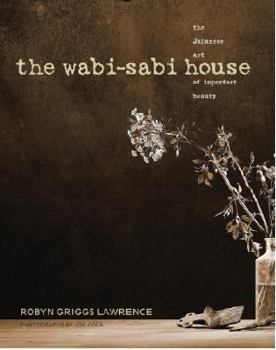The Wabi-Sabi House: The Japanese Art of Imperfect Beauty
What is wabi-sabi? Simply put, wabi-sabi is the marriage of the Japanese wabi, meaning humble, and sabi, which connotes beauty in the natural progression of time. Together, the phrase invites us to... This description may be from another edition of this product.
Format:Hardcover
Language:English
ISBN:1400050464
ISBN13:9781400050468
Release Date:November 2004
Publisher:Clarkson Potter
Length:192 Pages
Weight:1.45 lbs.
Dimensions:9.3" x 0.7" x 7.2"
Customer Reviews
5 ratings
wabi-rific
Published by Thriftbooks.com User , 17 years ago
i like this book for several reasons. first, it is just aesthetically pleasing to look at and to hold. a great coffee table book. secondly, it is written in a way that weaves together history and examples of the philosophy of wabi sabi with many areas of interest (i.e. architecture, art, tea ceremony, design, sense of self). it is easy and relaxing to read. an interesting idea and nice book.
A good organizational reference book
Published by Thriftbooks.com User , 19 years ago
There is so much beauty in simplicity. This book offers many helpful suggestions in how to simplify your decor and your life.
A wonderful book!
Published by Thriftbooks.com User , 19 years ago
I have told everyone I know to get this book as a starter to the world of Wabi-Sabi-- a beautiful cover also makes it lovely to look at and I like the sepia pages... I have re-examined my life using some of her practical tips. Get it if you are curious about this art of imperfection...
How wabi sabi goes beyond the house
Published by Thriftbooks.com User , 20 years ago
I have read a handful of books dealing with the Japanese concept of wabi sabi (variously translated as "the art of imperfection" or "the beauty of the old and the new"), everything from Soetsu Yanagi to Leonard Koren. This book by Robyn Griggs Lawrence continues in the same vein of trying to put into words for a Western audience an amorphous and ambiguous idea, specifically as it applies to home decor. For the most part the author gets it right. She gives the reader a little bit of historical background into the idea (its roots in Zen Buddhism and development from the tea ceremony) and then shows examples of how to put it into practice in a Western context. This is not a book about decorating your home in a neo-Japanese style, but rather how to make tangible a Japanese-originated aesthetic philosophy. In some ways, she goes beyond the strict confines of home decor and discusses wabi sabi in other areas of life, which is appropriate because wabi sabi, as I unerstand it, is really a whole school of thought. In one chapter she delves into crafts, from knitting to woodworking to cooking. I found this interesting because I am a hobby woodworker/furniture maker who is slowly crafting most of the furniture my family lives with. I realized, in reading this book, that wabi sabi is an aesthetic I have been reaching for in a number of areas without knowing until recently what it was called. For years I have been interested in a variety of topics, including Zen, environmentalism, the voluntary simplicity movement, modern design and architecture, and woodworking. Wabi sabi is the theme that ties these interests together. It is an approach to life, not just a decorating style or, worse, a magical, mystical belief in the power of red satin under your mattress and mirrors above your stove (`a la "feng shui", the popular Chinese-based belief in the flow of energy patterns in a building). While mostly positive about this book, I do have a couple bones to pick. Griggs Lawrence is a big advocate of shopping in flea markets and antique stores, looking for the piece with just right wabi sabi patina of age and imperfection. Personally, I have no use for other people's old stuff. Just 'cause it's old, don't make it valuable. Why would I want to buy somebody else's history? To me, finding something that is fresh and new, innovative in the way it accomplishes a task, simple and engaging in its design, and gets incorporated into my daily routine is a better expression of wabi sabi than finding an old wash basin at a garage sale and using it as a fruit bowl. Case in point: Griggs Lawrence has a predilection for a good cup of tea and even takes a swipe at Americans and their need for fancy cappuccino makers. Whoa there! Now she's hitting a little too close to home. My wife and I love a good cappuccino. Last Christmas I bought us what many might consider an extavagant Italian coffee machine. In actuality, it is quite simple (no fancy automatic controls)
A new way of thinking about my home
Published by Thriftbooks.com User , 20 years ago
I've only started reading The Wabi-Sabi House by Robyn Griggs Lawrence, but I was immediately mesmerized by her chapter "Give Space a Chance," which explains why an uncluttered, simple approach to rooms is so comfortable and appealing. Already I've started pulling knickknacks and books off the shelves in our living room to create a quieter, more Zenlike atmosphere. And, I've reorganized my bedroom dresser (using Lawrence's suggestion to undertake just one small thing at a time so as not to be overwhelmed). Now my overflowing jewelry box has been augmented with a jewelry drawer that hides little trays that hold all my earrings so I can see them quickly and easily. I'm sure the rest of the chapters in this book will inspire me to make other changes in my living and storage spaces so that my lovely home can become even more beautiful and sanctuary-like.






